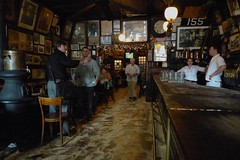One of the neighborhood’s most famous landmarks has joined the chorus for an historic district in the neighborhood.
In the past, the owner of McSorley’s Old Ale House was wary of any regulation of renovations to their building at 15 East Seventh Street. But now they would rather be included in the 330 buildings that comprise the proposed East Village-Lower East Side Historic District.
“We’ve surrendered to it, it’s time,” said Bill Wander, an unofficial historian of the bar who is close to its owner. “Now that the rest of the neighborhood is going to be protected, let’s not be left out.”
McSorley’s embraces its history as much as any business in the East Village. In February, for example, the McSorley’s Militia celebrated its 158th anniversary with a five-gun salute in Revolutionary War garb. Still, bar owner Matthew Maher had been skeptical of the designation for the typical reasons — the approval process involved in replacing things like windows and air conditioning units.
Mr. Wander, who spoke in favor of the district at the public hearing two weeks ago at the request of the bar’s owner, said he understood why many local religious institutions still are against it. But Mr. Maher decided the additional protection of the building was ultimately a good thing.
Rumors that the building housing the bar is for sale are “absolute nonsense,” he said, adding, “Matty’s got four daughters. No one is interested in selling McSorley’s.”
Still, the bar has had eviction scares in the past. In the 1960s the city considered seizing McSorley’s property on East Seventh Street and turning it over to Cooper Union. The historic district would mean even less of a chance of a similar threat ever reappearing, Mr. Wander said.
They’ve had to jump through more bureaucratic hoops lately, anyway. Last year the Health Department forced the owner to clean off the dusty wishbones hanging above the bar and kick out his beloved cat during business hours.
Mr. Wander joked that the historic district could officially designate McSorley’s as historic in the eyes of the city, though drinkers have known it’s historic for years. Early postcards for McSorley’s already called it a landmark, he said, and modern postcards call it a “landmark of old New York.”
“There are landmarks, and there are landmarks,” he said.





